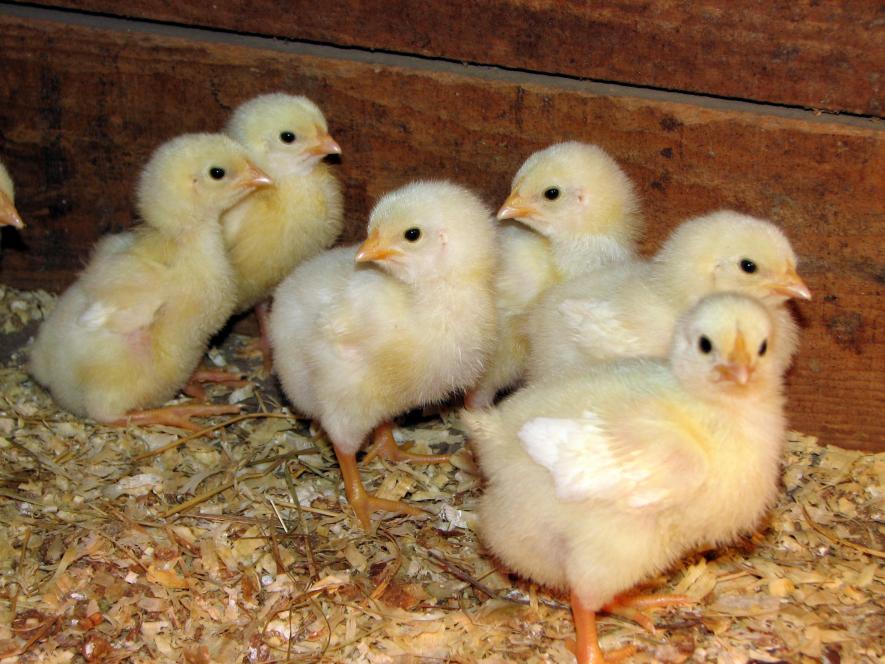Will the US Poultry Industry Adopt Tech That Could Save Billions of Baby Chicks?

Image Courtesy: Wikimedia Commons
Yes, “chick sexing” is a job. Industrial egg hatcheries hire people to look at the undersides of just-hatched chicks for eight hours a day. Some chick sexers average more than 1,000 chicks per hour, using conveyor belts to send the girls in one direction and the boys in another.
The egg industry needs chick sexers because female and male chicks suffer very different fates. The females become the next generation of laying hens, while the male newborns—considered useless to egg farmers—are sent straight into grinders to their deaths.
From 2020, the US egg industry was supposed to stop pulverising more than 300 million live baby male chicks every year. (The worldwide number is roughly 7 billion.) United Egg Producers (UEP), an agricultural cooperative whose members collectively produce over 90 per cent of the eggs commercially sold in the US, set this cull-free goal in 2016. Yet even as 2020 comes to an end, the practice of killing new-born males continues unabated.
UEP committed to the goal of ending the killing of day-old male chicks because several university labs and startup groups had already been working on “in-ovo sexing” technologies for years. Using high-tech approaches such as biomarkers, gene editing, fluorescence spectroscopy and magnetic resonance imaging, scientists have been seeking to efficiently and accurately identify the sex of an egg as early as possible during incubation. With the operational use of these technologies, eggs identified as male would not need to be incubated, and no chicks would have to be killed.
“Cull-free” eggs—eggs laid by hens from hatcheries that use in-ovo sexing technology to detect male eggs before they hatch are already available in grocery stores in some countries, although not the US companies selling cull-free eggs in Germany, France and the Netherlands have been using respeggt’s biomarker cull-free approach to egg sexing since 2018. In 2019, Carrefour in France began selling cull-free eggs that use a spectrophotometric process for in-ovo sexing.
US egg hatcheries consider the in-ovo sexing methods used by these European egg producers to be too slow and expensive. In July 2020, UEP issued a statement claiming that day-old male chick killing in the US continues four years after its 2016 announcement because “a workable, scalable solution is not yet available.” Solutions are available, but U.S. hatcheries are choosing to wait for a faster and cheaper technology.
To enable in-ovo sexing technologies to reach a level of performance accepted by the U.S. egg industry, two nonprofit organizations launched an “Egg-Tech Prize” competition in 2019. The Foundation for Food and Agriculture Research (FFAR) and Open Philanthropy (OP) have committed a combined $6 million—to be awarded in two phases—to advance high-potential in-ovo sexing technologies. In November of 2019, under Phase I, seed funding of around $2 million was divided among six university labs and startup companies to further the research that they had already started. In Phase II, those six and other interested applicants will compete for the grand prize of up to $3.7 million. Barring delays due to the pandemic, FFAR and OP will announce the Egg-Tech Prize winner in late 2021.
The high-tech startup funding model being applied in the US to stop the killing of male chicks is also being used to develop cultivated meat. Multiple companies are racing to raise capital and achieve scale as sustainable “clean meat” businesses, with the dual objectives of generating profit and reducing animal meat consumption. But the more typical approach to advocating for animals involves applying external pressure—usually some combination of legislative mandates and demands from major buyers—to force factory farming companies to make changes for the benefit of animals.
The cage-free movement provides an example of external pressure applied successfully. Advocacy groups convinced several large egg customers, including McDonald’s, to announce publicly that they would buy only cage-free eggs after a certain date. Added pressure on egg producers came from ballot initiatives such as California’s Proposition 12, which established minimum space requirements for laying hens.
Now, several years after this external pressure compelled the industry to change, egg companies and associations prominently display their commitment to the cage-free movement. The largest egg company in the US, Cal-Maine Foods, publicly touts that it has already invested over $310 million—almost 100 times more than the Egg-Tech grand prize—to expand its cage-free facilities. The combination of large-customer ultimatums, public transparency and legislative pressure is improving animal welfare.
Meanwhile, a lack of external pressure to stop killing new-born male chicks is allowing the egg industry to adopt a wait-and-see stance regarding in-ovo sexing technology. Other than a $100,000 donation from the US Poultry Foundation to the Egg-Tech Prize fund (added in February 2020 to the $6 million founding contribution by FFAR and OP), no public evidence exists that the egg industry is investing in providing solutions to chick culling. (Requests for interviews on the subject with UEP, the U.S. Poultry & Egg Association, Cal-Maine Foods, Rose Acre Farms, Hy-Line International and Vital Farms were all declined or went unanswered.) US poultry farms, as customers of the hatcheries, have set no deadlines for buying layer hens from cull-free hatcheries only.
This dearth of industry engagement is a primary reason why OP decided to sponsor the Egg-Tech Prize. According to Lewis Bollard, program officer for farm animal welfare at OP, “A big part of the reason why we felt the need to do something was the feeling that the industry wasn’t going to solve this on their own.”
Grants like the Egg-Tech Prize and any follow-on investments by venture capitalists, while laudable, do not guarantee that a successful, sustainable in-ovo sexing technology will emerge and thrive at scale in the U.S. Timothy Kurt, scientific program director at FFAR and director of the Egg-Tech Prize, hopes that the approximately $3.65 million Phase II prize will enable its winner to develop a technology that meets the industry’s demands for speed, accuracy and hatchability rates. But Kurt acknowledges that, in addition to the Egg-Tech Prize, follow-on investments by venture capitalists (VC) will be needed to bring the winning technology to operational readiness and industry-wide implementation.
Even with grant money and VC funding, entrepreneurial efforts are risky; roughly 30 per cent of new businesses fail within two years and 70 per cent fail within ten. Whether any of the in-ovo startup companies can translate a successful technology into a sustainable enterprise at scale is still an open question.
The Silicon Valley model can effectively build successful companies, but achieving a meaningful scale usually takes time—meaning that the long-standing practice of male chick killing in the US will likely continue substantially beyond 2020. Until a new tech company focused on in-ovo sexing meets the operational and financial criteria demanded by the nation’s egg industry, hatcheries will continue to shred to death roughly 1 million new-born male chicks each day. For now, the wait continues for more rounds of funding and for the end of another factory farming practice that prioritixes profits and operational efficiency over animal welfare.
In the meantime, consumers can ask nearby family farms if they sell cull-free eggs; if the farm gets its laying hens from a US hatchery, the eggs are almost certainly not cull-free. Neither do any of the labels that some consumers look for—including “cage-free,” “free-range,” “pasture-raised,” “ethical eggs,” “certified humane,” “USDA organic,” or “non-GMO”—indicate cull-free eggs. Consumers can contact United Egg Producers to urge them to demand that the hatcheries supplying layer hens to most US farms begin implementing in-ovo sexing technologies.
Linda Tyler is a freelance writer who focuses on farmed animal welfare and industrial factory farming. She is a writing fellow at Sentient Media. The views are personal
This article was produced by Earth | Food | Life, a project of the Independent Media Institute.
Get the latest reports & analysis with people's perspective on Protests, movements & deep analytical videos, discussions of the current affairs in your Telegram app. Subscribe to NewsClick's Telegram channel & get Real-Time updates on stories, as they get published on our website.























